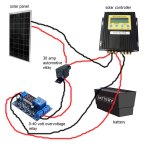I've got three lithium battery packs built for electric bikes, each a different capacity, from 300 to 500 watt hours. I'm thinking about using them as a battery bank in my RV since my lead acid batteries are about 6 years old now.
I've got a few questions for the lithium battery wizards:
- I'm guessing I can't put all 3 battery packs in parallel, since they're likely to be at different voltages. Correct?
- If each battery pack needs to be separate, I was considering using something like this to charge each one. Does that sound adequate? Or is there something better to use?
https://www.amazon.com/Numerical-Regulator-10V-120V-Converter-Adjustable/dp/B01GFVI6R6
- What's the max current that I should be charging the packs with?
- For battery longevity, should I use a lower voltage than the full 42 volts? From reading here, is 41 volts the recommendation?
- Any suggestion for a watt meter that I can put on each battery pack that would tally the watt hours in and out? The one I have only shows watt hours in one direction.
- I've seen some mention of 3 phase charging for lithium batteries. I know lead acid uses 3 phases (bulk, absorption, float), does lithium need something similar, or is a constant voltage sufficient?
Thanks for any help.
I've got a few questions for the lithium battery wizards:
- I'm guessing I can't put all 3 battery packs in parallel, since they're likely to be at different voltages. Correct?
- If each battery pack needs to be separate, I was considering using something like this to charge each one. Does that sound adequate? Or is there something better to use?
https://www.amazon.com/Numerical-Regulator-10V-120V-Converter-Adjustable/dp/B01GFVI6R6
- What's the max current that I should be charging the packs with?
- For battery longevity, should I use a lower voltage than the full 42 volts? From reading here, is 41 volts the recommendation?
- Any suggestion for a watt meter that I can put on each battery pack that would tally the watt hours in and out? The one I have only shows watt hours in one direction.
- I've seen some mention of 3 phase charging for lithium batteries. I know lead acid uses 3 phases (bulk, absorption, float), does lithium need something similar, or is a constant voltage sufficient?
Thanks for any help.



